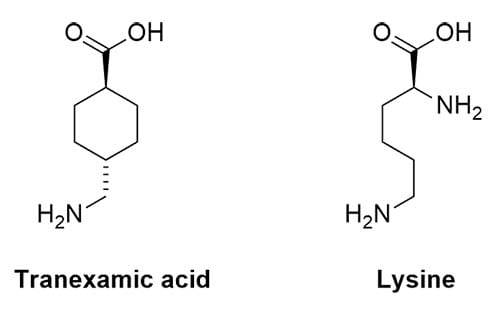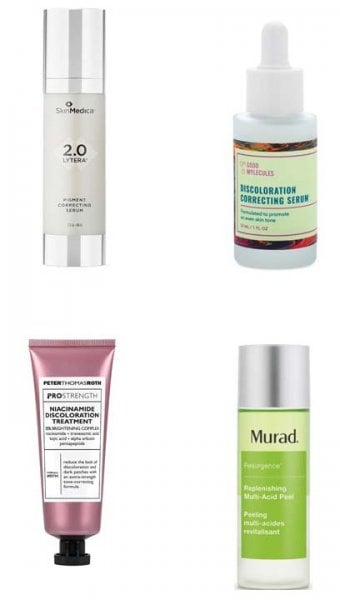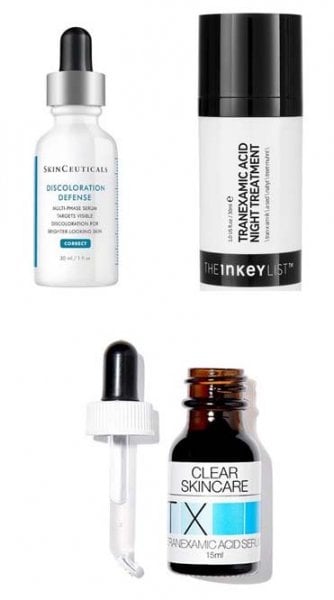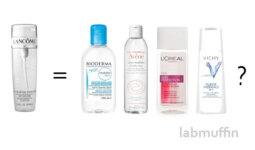What is tranexamic acid?
Tranexamic acid (TXA for short) is a relatively new ingredient in skincare. It’s a synthetic derivative of the amino acid lysine:

You can take tranexamic acid orally as a tablet, apply it topically on your skin as a cream or serum, or have it injected into the lower layers of your skin (the dermis).
Oral tranexamic acid has been used for reducing bleeding for a long time, in situations like heavy menstrual periods, nosebleeds and surgery. In the last 5-10 years, dermatologists have also started using tranexamic acid for pigmentation disorders, especially melasma.
Related post: What are the skin lightening alternatives to hydroquinone?
What is melasma?
Melasma is a skin condition where blotchy patches of brown pigment develop, mostly on the face. Both environmental and genetic factors can contribute to melasma, including hormonal changes (like pregnancy) and UV radiation. It’s more likely to happen in people of Asian, African, and Hispanic descent.
How melasma develops isn’t well understood. It seems to involve a complex interaction between various types of skin cells (including pigment-containing melanocytes), inflammation, hormones, sun damage and blood vessels.
How does tranexamic acid work?
Most of the studies on tranexamic acid and skin have been on taking it orally for melasma. It’s proposed that tranexamic acid tackles melasma in a number of different ways:
- It interferes with the interaction of pigment-producing melanocyte cells and regular keratinocyte skin cells
- It could decrease blood vessels in affected skin
- Tranexamic acid also decreases inflammatory mediators that stimulate pigment production after UV exposure
- It decreases the number of mast cells which release inflammatory mediators
- Since it’s structurally similar to tyrosine, it could also potentially slow down the production of melanin by tyrosinase (as a competitive antagonist)
(It does a lot of these by slowing down the production of plasmin, an enzyme in blood that breaks up clotting material – which is also why it’s used to slow down bleeding.)
Related post: Video: My Routine for Fading Acne Marks (Post-Inflammatory Hyperpigmentation)

Oral tranexamic acid
For melasma
Oral tranexamic acid is effective for treating melasma. It’s generally taken at a dose of 250 to 1500 mg daily, for 8 to 12 weeks. It has few side effects (mostly digestive ones, but it could potentially increase the risk of blood clots).
Since it’s relatively new, oral tranexamic acid has mostly been studied on Asian patients and there’s limited data on other ethnicities. It’s generally used when topicals, peels and lasers don’t work well enough or aren’t suitable, or in combination with one of the other melasma treatments.
For other types of pigmentation
Interestingly, oral tranexamic acid doesn’t seem to be as effective for other types of hyperpigmentation – in one study, it had almost no effect on freckles and age spots even though it faded melasma well. In a study where oral and topical tranexamic acid were used together, the skin around melasma patches darkened during treatment, which was thought to be due to increased sun exposure.
Oral tranexamic acid also doesn’t seem to work for preventing post-inflammatory hyperpigmentation after laser treatment.
Related post: Easy (5 Minute) DIY Vitamin C Serum Recipe

Topical tranexamic acid
Unfortunately, there’s a lot less evidence for tranexamic acid applied topically on the skin.
Like for oral tranexamic acid, most of the studies on topical tranexamic acid have been done on melasma. A few studies have found that tranexamic acid at 3-5% is as effective at fading melasma as 2-4% hydroquinone, with fewer side effects. Injections of tranexamic acid into the dermal layer of the skin has also been found to work for melasma.
In other types of pigmentation, there’s even less evidence. There are a few studies where tranexamic acid faded hyperpigmentation when combined with other ingredients known to fade pigment (kojic acid, niacinamide, alpha arbutin), but none where tranexamic acid was used alone.
Related post: What Is Niacinamide and What Does It Do in Skincare?
One area where I think tranexamic acid could be promising is for reducing skin redness. While there are a lot of other ingredients that can fade pigment, there’s a severe lack of skincare options for fading redness. Since tranexamic acid acts on blood vessels as well as pigment to fade melasma (this could partly explain its greater effectiveness compared to ingredients that solely act on pigment), it could potentially help fade redness. But again, there’s only very scant evidence available:
- There’s one report of nightly 5% tranexamic acid reducing post-inflammatory erythema (redness after acne) in 6-8 weeks
- A couple of preliminary studies have also been done using 10% tranexamic acid for erythematotelangiectatic rosacea
Related post: Common Rosacea Questions
Have you tried tranexamic acid? What was your experience?
References
McKesey J, Tovar-Garza A, Pandya AG. Melasma Treatment: An Evidence-Based Review. Am J Clin Dermatol. 2020;21(2):173-225. doi:10.1007/s40257-019-00488-w
Bala HR, Lee S, Wong C, Pandya AG, Rodrigues M. Oral Tranexamic Acid for the Treatment of Melasma: A Review. Dermatol Surg. 2018;44(6):814-825. doi:10.1097/DSS.0000000000001518
Perper M, Eber AE, Fayne R, et al. Tranexamic Acid in the Treatment of Melasma: A Review of the Literature. Am J Clin Dermatol. 2017;18(3):373-381. doi:10.1007/s40257-017-0263-3
Forbat E, Al-Niaimi F, Ali FR. The emerging importance of tranexamic acid in dermatology. Clin Exp Dermatol. 2020;45(4):445-449. doi:10.1111/ced.14115
Na JI, Choi SY, Yang SH, Choi HR, Kang HY, Park KC. Effect of tranexamic acid on melasma: a clinical trial with histological evaluation. J Eur Acad Dermatol Venereol. 2013;27(8):1035-1039. doi:10.1111/j.1468-3083.2012.04464.x
Wu S, Shi H, Wu H, et al. Treatment of melasma with oral administration of tranexamic acid. Aesthetic Plast Surg. 2012;36(4):964-970. doi:10.1007/s00266-012-9899-9
Rutnin S, Pruettivorawongse D, Thadanipon K, Vachiramon V. A Prospective Randomized Controlled Study of Oral Tranexamic Acid for the Prevention of Postinflammatory Hyperpigmentation After Q-Switched 532-nm Nd:YAG Laser for Solar Lentigines. Lasers Surg Med. 2019;51(10):850-858. doi:10.1002/lsm.23135
Kato H, Araki J, Eto H, et al. A prospective randomized controlled study of oral tranexamic acid for preventing postinflammatory hyperpigmentation after Q-switched ruby laser. Dermatol Surg. 2011;37(5):605-610. doi:10.1111/j.1524-4725.2011.01957.x
Anwar AI, Wahab S, Widita W, Nurdin AR, Budhiani S, Seweng A. Randomized control trial outcomes of tranexamic acid combination serum as a depigmenting agent for the use in healthy individuals. Dermatol Ther. 2019;32(6):e13146. doi:10.1111/dth.13146
Lee DH, Oh IY, Koo KT, et al. Reduction in facial hyperpigmentation after treatment with a combination of topical niacinamide and tranexamic acid: a randomized, double-blind, vehicle-controlled trial. Skin Res Technol. 2014;20(2):208-212. doi:10.1111/srt.12107
Desai S, Ayres E, Bak H, et al. Effect of a Tranexamic Acid, Kojic Acid, and Niacinamide Containing Serum on Facial Dyschromia: A Clinical Evaluation. J Drugs Dermatol. 2019;18(5):454-459.
Jakhar D, Kaur I. Topical 5% tranexamic acid for acne-related postinflammatory erythema. J Am Acad Dermatol. 2020;82(6):e187-e188. doi:10.1016/j.jaad.2019.09.074
Bageorgou F, Vasalou V, Tzanetakou V, Kontochristopoulos G. The new therapeutic choice of tranexamic acid solution in treatment of erythematotelangiectatic rosacea. J Cosmet Dermatol. 2019;18(2):563-567. doi:10.1111/jocd.12724
Jakhar D, Kaur I, Misri R. Topical 10% tranexamic acid for erythematotelangiectatic steroid-induced rosacea. J Am Acad Dermatol. 2022;86(1):e1-e2. doi:10.1016/j.jaad.2019.12.067






Sahu, P. J., Singh, A. L., Kulkarni, S., Madke, B., Saoji, V., & Jawade, S. (2020). Study of oral tranexamic acid, topical tranexamic acid, and modified Kligman’s regimen in treatment of melasma. Journal of Cosmetic Dermatology.
Interesting recent study in an Indian population comparing oral TXA (500mg/day) with Kligman’s formula (HQ + ATRA + steroid) and topical TXA (in a cream also containing kojic acid, arbutin, liquorice etc though….). It’s a small sample size, they didn’t study the TXA on it’s own (had a lot of other pigment faders in the cream) and no control was used, but interesting results!
Hi Michelle,
many thanks for the info. I haven’t tried any products with TXA so far, but I’m planning to buy the Skinceuticals TXA serum.
One silly comment, in your sentence “Unfortunately, there’s a lot less evidence for tranexamic acid applied topically on the skin” I think ’NOT’ has somehow disappeared from the sentence?!
Anyway, many thanks 🙂
I think that sentence makes perfect sense …
No that sentence makes sense. She is saying that compared to taking it orally, there is less evidence of its effectiveness when you apply it to the skin
Please forgive me, Michelle. It does make sense. I’m not really sure what happened to my brain. I didn’t see the ‘less’. I just saw Unfortunately, there’s a lot evidence for tranexamic acid applied topically on the skin”
Stupid me, sorry 🙂
My Curology cream has tranexamic acid in it. My provider said it might help to reduce skin redness from rosacea and KP on the face. Overall it has not really done anything for me in six months of use, unfortunately.
Hi Michelle – I am currently taking Tranexamic Acid in pill form for melasma. I”ve been on it for 90 days. My dermatologist has me on it in conjunction with a series of various laser treatments, and glutathione. Unfortunately because of COVID, I had to stop the laser treatments but have continued with just the TX pills. I can’t say if the pills or the lasers reduced my existing melasma but the most troublesome areas have disappeared (side burns). So the overall combined treatment appears to be working.
I found the section under “FOR OTHER TYPES OF PIGMENTATION” to be rather confusing, i think you should re-read that and correct it, maybe you were just tired from all that research and it was an oversight?
Is there any cream that can fade permanent hemodiderin staining? I bruised on my calves while taking low dose asprin and garlic capsules. The bruises are a hands breadth wide and still there after two years.
I really appreciate your article. I have been using 5% Tranex from Dearskin twice a day for less than a month. It was recommended by Penn Smith on You Tube. I haven’t had any bad side effects, but it is too early to tell if it is effective. Hope springs eternal, as they say. I’ll give this product 12 weeks. If I haven’t had any results, Curology, here I come.
I tried oral tranexamic acid for both periods and melasma. I was hoping for a two for one situation. I live in the states and had to ask specifically for it since no doctor ever brought it up as an option. My doctor prescribed it after looking at the literature because it seemed promising. Unfortunately, I was one of the few to have a rare side effect of terrible headaches, which was a bummer. I used it for a few months and didn’t actually see much improvement for melasma, so I’m starting to wonder if my hyperpigmentation is technically not melasma. It was worth a try though!
I’m 60, with age spots. I have tranexamic acid in my Curology serum. It’s 2%, along with 4% niacinimide and .02% tretinoin. I haven’t noticed any lightening of age spots, unfortunately. The tretinoin is great for my fine lines, and my skin looks smoother and has a glow. However, skin lightening has been disappointing. I’ve seen slight results on a few spots on my hands and arms from Paula’s Choice 8% AHA. But it doesn’t work on all of them for some reason. It sounds like it would be better to modify my serum, and switch the tranexamic acid with another active. Thanks for the info on the studies.
As someone with light melasma but who loves her freckles this seems like a great option!
Exciting stuff as I have a lot of melasma due to pregnancy. Mine developed post partum oddly enough. Any info on whether this is safe for pregnant or nursing women? Is it a one time treatment or will melasma return and need further treatment?
I use Tranexamic Acid as part of my “fading hyperpigmentation” routine, but haven´t seen groundbreaking changes. The most effective was the introduction of retinoids two years ago.
Wow! This is really perfect for your skin.
Is tranexamic acid more efective than niacinamide?
Depends what for – but I’d go with niacinamide over tranexamic acid for pretty much everything but melasma.